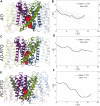Molecular Insights Into Binding and Activation of the Human KCNQ2 Channel by Retigabine
- PMID: 35309507
- PMCID: PMC8927717
- DOI: 10.3389/fmolb.2022.839249
Molecular Insights Into Binding and Activation of the Human KCNQ2 Channel by Retigabine
Abstract
Voltage-gated potassium channels of the Kv7.x family are involved in a plethora of biological processes across many tissues in animals, and their misfunctioning could lead to several pathologies ranging from diseases caused by neuronal hyperexcitability, such as epilepsy, or traumatic injuries and painful diabetic neuropathy to autoimmune disorders. Among the members of this family, the Kv7.2 channel can form hetero-tetramers together with Kv7.3, forming the so-called M-channels, which are primary regulators of intrinsic electrical properties of neurons and of their responsiveness to synaptic inputs. Here, prompted by the similarity between the M-current and that in Kv7.2 alone, we perform a computational-based characterization of this channel in its different conformational states and in complex with the modulator retigabine. After validation of the structural models of the channel by comparison with experimental data, we investigate the effect of retigabine binding on the two extreme states of Kv7.2 (resting-closed and activated-open). Our results suggest that binding, so far structurally characterized only in the intermediate activated-closed state, is possible also in the other two functional states. Moreover, we show that some effects of this binding, such as increased flexibility of voltage sensing domains and propensity of the pore for open conformations, are virtually independent on the conformational state of the protein. Overall, our results provide new structural and dynamic insights into the functioning and the modulation of Kv7.2 and related channels.
Keywords: Kv7.2; docking; homology modelling; molecular dynamics; retigabine; voltage-gated potassium channels.
Copyright © 2022 Garofalo, Bonvin, Bosin, Di Giorgio, Ombrato and Vargiu.
Conflict of interest statement
BG, FD, and RO are employees of Angelini Pharma S.p.A., which funded this research under the project “In silico characterization of the open and closed structures of the KV7.2 potassium channel.” The remaining authors declare that the research was conducted in the absence of any commercial or financial relationships that could be construed as a potential conflict of interest.
Figures





Similar articles
-
Retigabine holds KV7 channels open and stabilizes the resting potential.J Gen Physiol. 2016 Mar;147(3):229-41. doi: 10.1085/jgp.201511517. Epub 2016 Feb 15. J Gen Physiol. 2016. PMID: 26880756 Free PMC article.
-
The Sensorless Pore Module of Voltage-gated K+ Channel Family 7 Embodies the Target Site for the Anticonvulsant Retigabine.J Biol Chem. 2016 Feb 5;291(6):2931-7. doi: 10.1074/jbc.M115.683185. Epub 2015 Dec 1. J Biol Chem. 2016. PMID: 26627826 Free PMC article.
-
Electrophysiological and pharmacological characterization of a novel and potent neuronal Kv7 channel opener SCR2682 for antiepilepsy.FASEB J. 2019 Aug;33(8):9154-9166. doi: 10.1096/fj.201802848RR. Epub 2019 May 7. FASEB J. 2019. PMID: 31063701
-
Identifying the mechanism of action of the Kv7 channel opener, retigabine in the treatment of epilepsy.Neurol Sci. 2023 Nov;44(11):3819-3825. doi: 10.1007/s10072-023-06955-x. Epub 2023 Jul 13. Neurol Sci. 2023. PMID: 37442907 Review.
-
The therapeutic potential of neuronal KCNQ channel modulators.Expert Opin Ther Targets. 2003 Dec;7(6):737-48. doi: 10.1517/14728222.7.6.737. Expert Opin Ther Targets. 2003. PMID: 14640909 Review.
Cited by
-
In Silico Methods for the Discovery of Kv7.2/7.3 Channels Modulators: A Comprehensive Review.Molecules. 2024 Jul 8;29(13):3234. doi: 10.3390/molecules29133234. Molecules. 2024. PMID: 38999185 Free PMC article. Review.
References
-
- Ashcroft F. M. (2000). Ion Channels and Disease. Oxford, UK: Elsevier.
-
- Basciu A., Koukos P. I., Malloci G., Bonvin A. M. J. J., Vargiu A. V. (2019a). Coupling Enhanced Sampling of the Apo-Receptor with Template-Based Ligand Conformers Selection: Performance in Pose Prediction in the D3R Grand Challenge 4. J. Comput. Aided Mol. Des. 34, 149–162. 10.1007/s10822-019-00244-6 - DOI - PubMed
LinkOut - more resources
Full Text Sources

